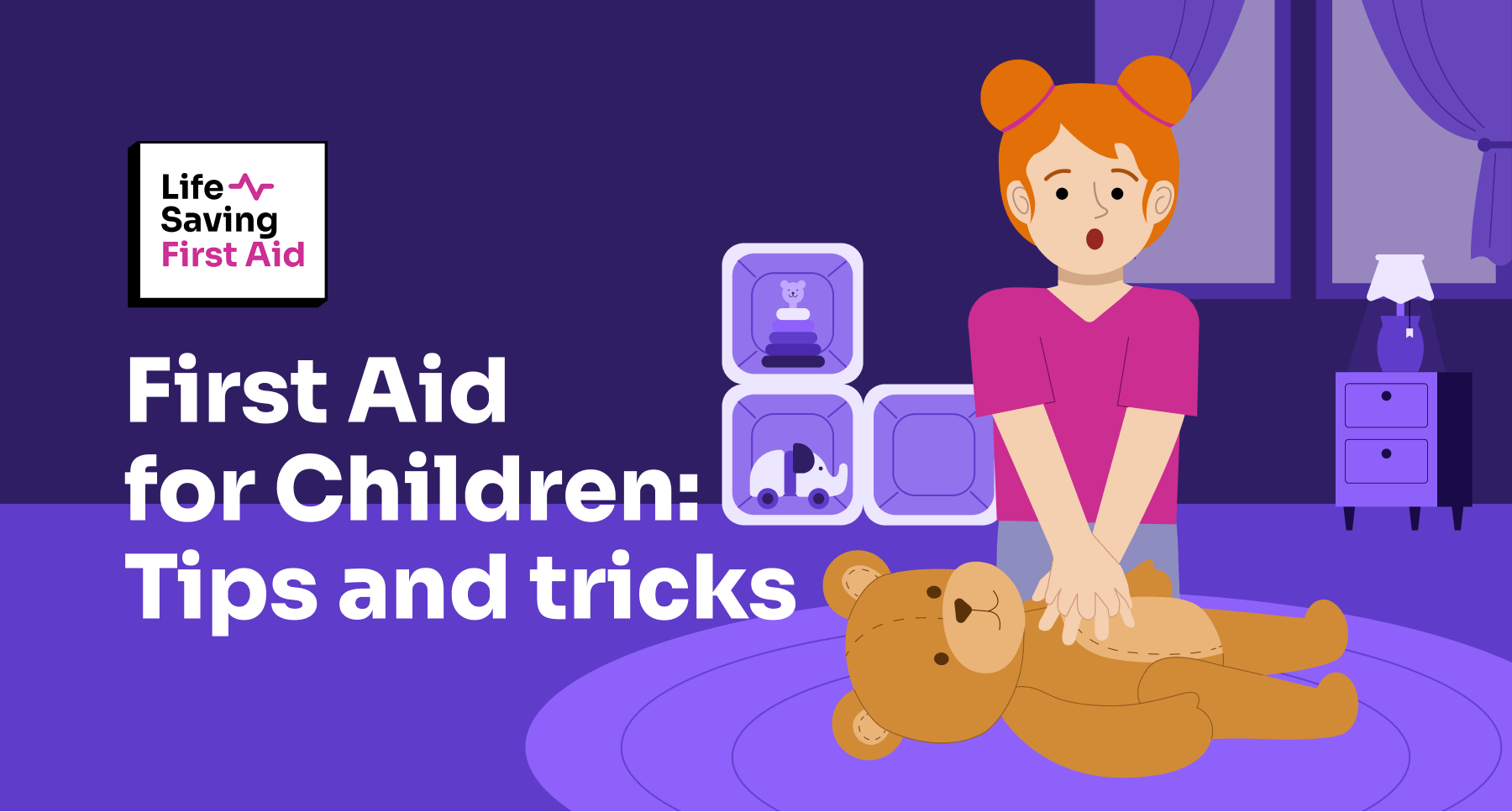First Aid for Children – Introduction
Knowing how to administer first aid to children can be a lifesaver for parents or carers. Accidents can happen at any time and place, and knowing how to react swiftly can make all the difference.
How many children die from injuries? According to the AIHW –
“During 2015–2017, injuries contributed to 563 deaths of children aged 0–14—a rate of 4.1 per 100,000 children. The rate of injury deaths for boys (4.9 per 100,000) was 1.5 times as high as that for girls (3.2 per 100,000) (Figure 1).The youngest children (aged 0–4) had the highest rate of injury death (6.1 per 100,000 infants), compared with children aged 5–9 (2.1 per 100,000) and 10–14 (4.1 per 100,000).Injury deaths comprised a substantial proportion of all deaths among those aged 1–14 (33%)”
Approximately 10 deaths per week!
In this article we will go over some of the fundamentals of paediatric first aid. In addition, we will cover some common practices and helpful hints for parents and carers.
We encourage all parents to take first aid classes so that they will be prepared in the event of an emergency.
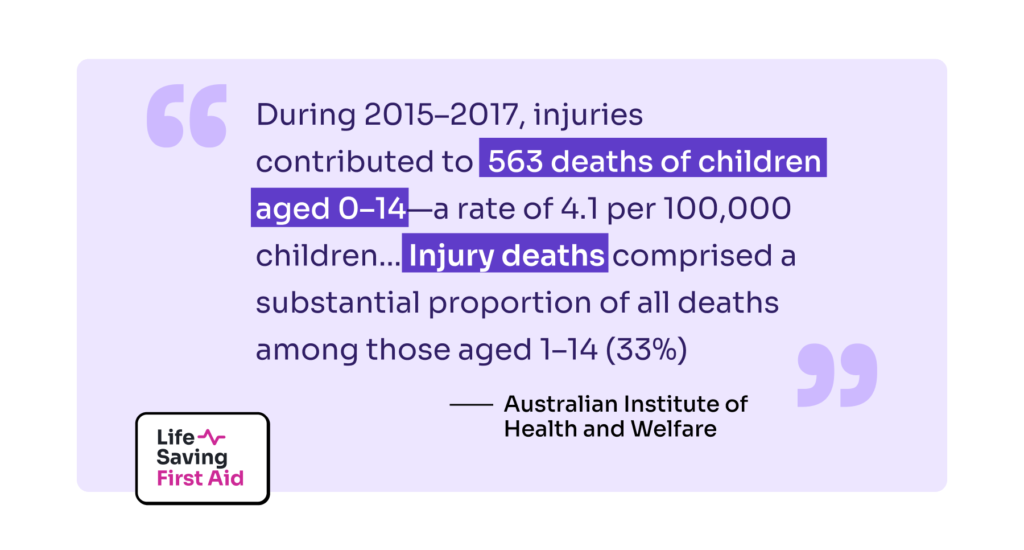
Common childhood emergencies
Some of the most common emergencies that can require first aid for children include:
1. Choking: Children may choke on small objects or food, which can cause breathing difficulties and even lead to suffocation.
2. Cuts and scrapes: Children are often active and can suffer cuts, scrapes, and bruises while playing or exploring.
3. Burns: Children may accidentally touch hot surfaces or spill hot liquids, resulting in burns or scalds.
4. Allergic reactions: Children can have allergic reactions to foods, insect bites or stings, or medications, which can cause hives, difficulty breathing, or anaphylaxis.
5. Poisoning: Children can accidentally ingest harmful substances, such as medications, cleaning products, or chemicals.
6. Fractures and sprains: Children may suffer fractures or sprains from falls or sports injuries.
7. Seizures: Seizures can occur in children with epilepsy or other medical conditions and can be scary for the child and those around them.
8. Nosebleeds: Nosebleeds can happen for various reasons, including dry air, allergies, or trauma to the nose.
It’s essential for parents and caregivers to be prepared for these emergencies and know how to administer first aid to children.
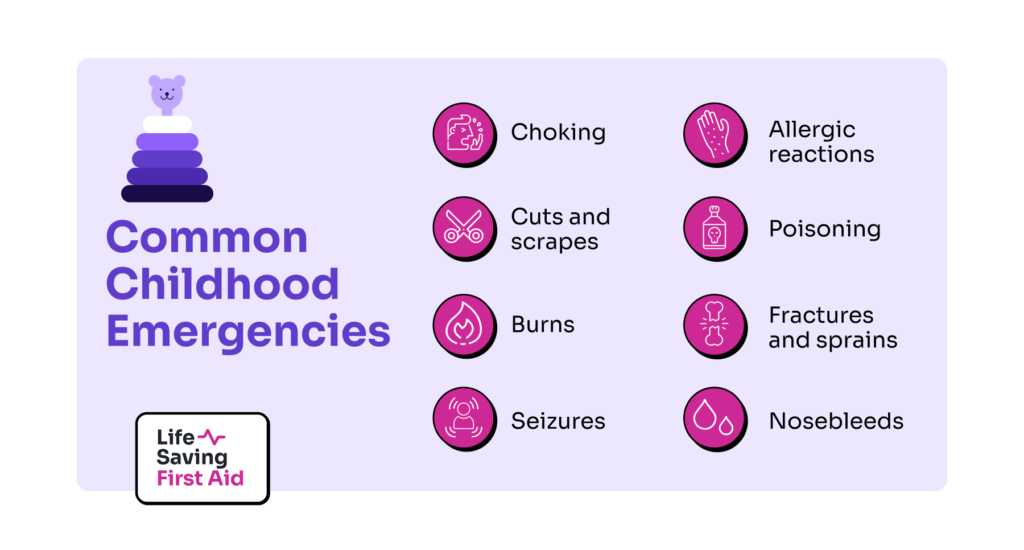
First aid courses
To effectively deal with potential harm or injury to children in Australia, it is recommended that parents or caregivers undertake a nationally accredited course. The most appropriate nationally accredited courses in Australia are.
· HLTAID009 Provide cardiopulmonary resuscitation (CPR Only).
· HLTAID011 Provide First Aid.
· HLTAID012 Provide First Aid in an education and care setting (appropriate for those who work in an education and care setting).
· Baby First Aid Course (non accredited course, useful information specifically for infant and baby first aid).
These courses include practical instruction on administering First Aid and CPR to children. Because you are administering first aid to children, you should also make other considerations.
Staying calm
This is one of the most important things to remember when faced with an emergency involving a child. When a child is injured, it is essential to remain calm and composed as panic can quickly set in.
Stay calm. Assess the situation accurately and make informed decisions about the necessary first aid.
Panicking can lead to further injuries or mistakes, such as administering incorrect first aid, forgetting to call for professional help (triple 000), or even causing additional distress and harm to the child. By staying calm, your actions reassure the child and those around them.
If a child falls and appears to have hurt their arm, staying calm can help you to assess the situation accurately. You may be able to see if the child is in extreme pain or the arm has a visible deformity. This can help you decide whether seeking medical attention is required.
If the child is crying, staying calm can help you to provide reassurance and comfort while administering appropriate first aid measures, such as applying a cold compress or immobilising the affected area.
So, take a few deep breaths, focus, and always stick to your training. Let’s consider some first aid scenarios specific to children and the best course of action to take.
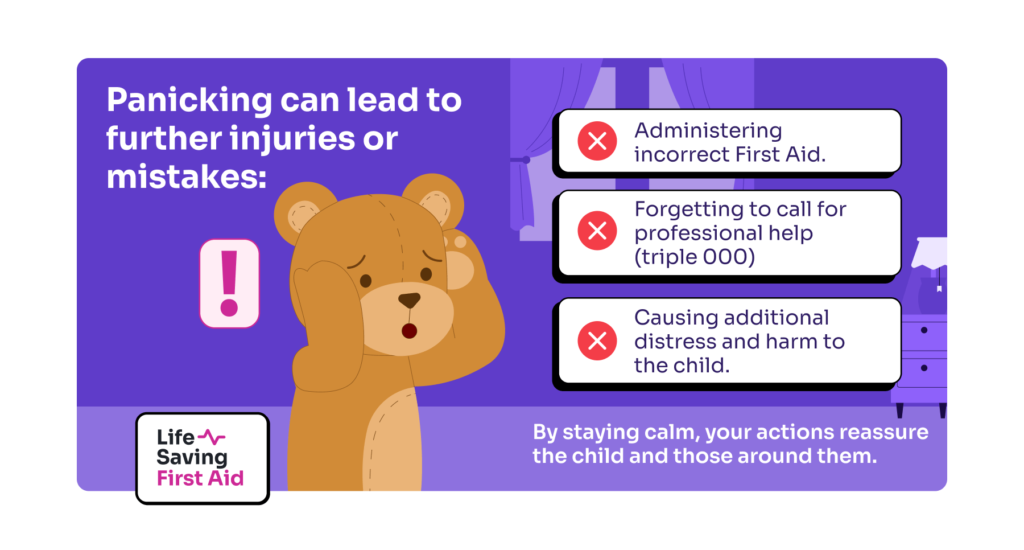
Considerations
Children are different to adults. Here’s some considerations to make when providing first aid to children.
Observe all age-appropriate techniques outlined in the nationally accredited first aid courses: When administering CPR (Course Code HLTAID009) to an infant, it is suggested to use two fingers for chest compressions, which differs from the technique used for helping an older child or adult.
Comfort and reassurance: During a medical emergency, children may feel scared or experience pain, so it is crucial to provide comfort and ease while administering first aid. This can include holding their hand, using a calm tone, and explaining what you’re doing as you go.
Emotional support: Children may need emotional support following an emergency in addition to physical first aid. You can provide reassurance by holding their hand and validating their feelings by acknowledging how they are feeling. Encouragement is also important, so tell the youngster they’re doing a fantastic job and that they’re courageous. A toy or a tale, for example, might assist in taking their mind off the situation and give a reprieve from any worry or anxiety. Following the administration of first aid, check in with the child to see how they are doing and provide any extra help they may require. Offering emotional support in these ways may make the youngster feel more supported and empowered through a challenging moment.
Consent
When administering first aid to a child, obtaining their consent is important. Children should be informed and involved in their healthcare decisions as much as possible.
According to Australian emergency law (https://australianemergencylaw.com/) a child can consent to receiving first aid care provided they understand fully what the first aider is saying. Therefore it’s important to explain to the child what you’re going to do. Get consent before proceeding with any first aid. This can build trust between the child and caregiver and help the child feel more in control of the situation.
If the child is unconscious or unable to consent, the first aider should act in the casualties’ best interests and within the limits of their training. Where the first aider is also the caregiver, day-care worker for example, the caregiver must make an informed decision about what actions to take based on the situation and the child’s medical history. For example, if a child is having an allergic reaction and is unconscious, and breathing, it’s appropriate for the first aider to administer an epinephrine auto-injector as it could potentially save the child’s life.
It’s also important to note that a child’s consent is not always necessary in emergencies where the caregiver must act quickly to prevent further harm. In these cases, caregivers must act in the child’s best interest to provide the necessary care.
Allergies and Medical conditions
Consideration of allergies and medical conditions:
When providing first aid to children, it is vital to consider any allergies or medical conditions they may have. Because allergic reactions can be life-threatening, carers must be aware of the child’s sensitivity and take appropriate precautions. For example, if you know that a child is allergic to latex, you can use gloves that are latex-free.
It is also crucial to be aware of any pre-existing medical difficulties the child may have had. When delivering first aid, caregivers should be mindful of the child’s medical history and any potential risks. A child with a heart condition may have contraindications to specific therapies or medications.
Conclusion
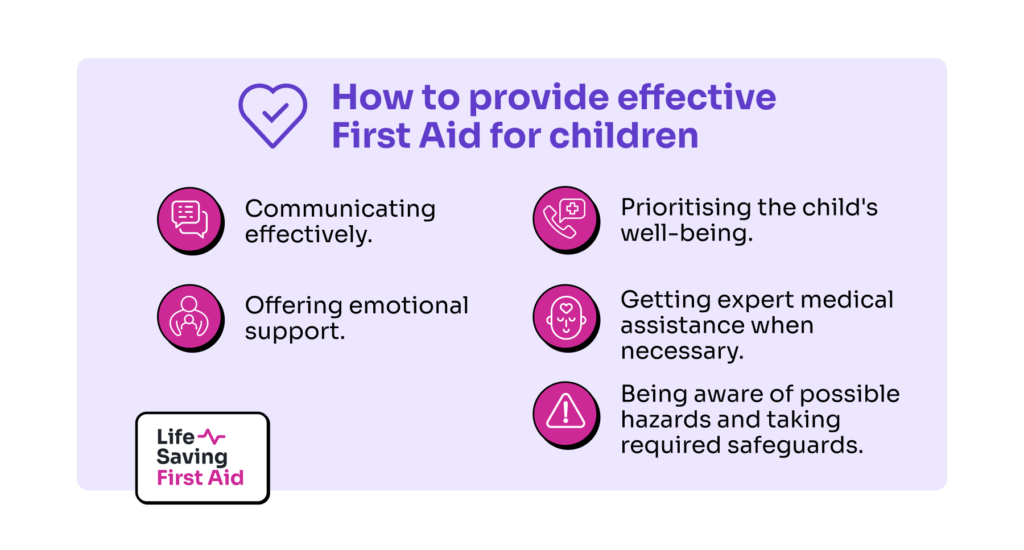
Finally, providing first aid to children necessitates unique considerations and procedures. There are various crucial tips and methods that help you provide safe and effective care.
These include:
- communicating effectively
- offering emotional support
- being aware of possible hazards and taking required safeguards
- stay calm and respond swiftly
- prioritising the child’s well-being
- getting expert medical assistance when necessary
By following these tips, we can ensure that our children receive the greatest possible care and support during times of need.
Remember that knowing how to offer first aid to children can be a life-saving skill that can make all the difference in an emergency.
Until next time this is trainer Nick. Be safe
